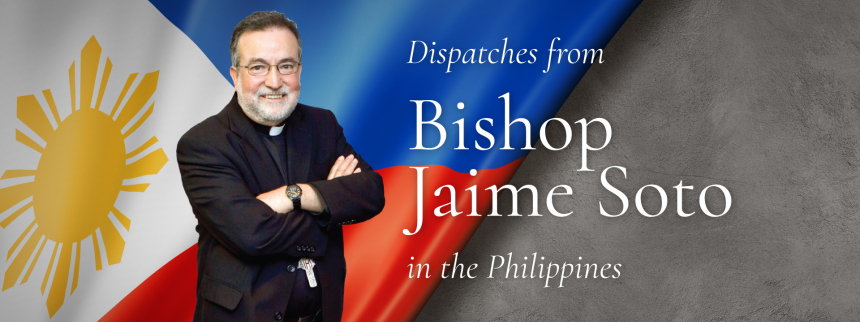
Yesterday with about 32 members of the faithful from the Diocese of Sacramento and two of my brother priests, I arrived in bustling capital of the Philippines, Manila. It is good to come back to this Asian Pacific Archipelago.
There has been much rumination these days around flights delayed and cancelled due to circumstances of nature, technology, and human foibles. Our arrival in the Philippines had been delayed by two years. The original plan was to come to this cluster of islands, tucked between Southeast Asia and Australia, in 2021 to participate in the 500th anniversary of Christian evangelization coming to the inhabitants of these places. The COVID-19 global pandemic put this aspiration on pause, first for one year, then two. Some of those who make up the current band of pilgrims waited out the long viral eclipse. In the meantime, others gladly joined in the opportunity to explore the amazing, rich religious heritage of the Philippines.
Manila does not have much charm. It shares the sprawling, alienating, garish chaos of most urban sectors in developing nations. I don’t hesitate to say that after finding more than enough concurrence among many Filipinos. The global grip of a culture promoted as well as created by technology flashes, blinks, wails, honks and grinds in major megalopoli from Mexico City and Lima to Ho Chi Minh City, Kolkata and Manila. With little exaggeration, there is not much difference between them except for the languages.
I do not suggest that anyone not born there attempt to drive in Manila. The logic of maneuvering through the streets and highways of the city’s constant congestion defies comprehension. I left the driving to those who obviously knew the code of when to stop, go, honk or shout out the window.
This may not seem like a tranquil transition into a religious pilgrimage, but the first impression’s jarring judgments eventually give way to rhythms and patterns that reveal the soul of a people.
Manila has a long history as a trading post. Even before Magellan met his demise on the island of Cebu, the people of the Philippine Islands were already trading with Asia. With the arrival of the Spaniards to the Manila harbor, a new chapter of globalized trading began that would forever change the course of the Philippines and the whole world. Porcelain, silk, silver, potatoes, chocolate, tobacco as well as diseases and bugs would be swapped among Asia, Latin America, and Europe along the shores of the Manila harbor.
On one of the shores of that harbor was built the Spanish walled settlement that today is called Intramuros (inside the walls). Here was an ancient military garrison that had served four conquering nations: Spain, the United States, and Japan then United States resumed control after World War II. The quiet and picturesque colonial spaces betrays the turmoils, treacheries, ambitions, and global rivalries witnessed by the mute stones and exotic tropical foliage that now commands the stately plazas and quaint courtyards.
Part of the Manila’s intramuros is the Cathedral. The monumental Catholic Cathedral does not have the age of the other buildings of this historical sector of the city. Due to the Second World War it had to be rebuilt and so continue the Church’s mission in the midst of history’s unending cycles of strife, conflict, destruction, and rebuilding. In my two previous trips to the Philippines I had not the chance to view the interior of the Cathedral. This time, the organizers fortunately finagled the opportunity to offer the first Mass of the pilgrimage in the Crypt of the archbishops of Manila. Not all the bishops who have served the people of Manila were buried in the crypt. There were only the most recent five, starting with the one who rebuilt the Cathedral after the War.
Here was a quiet haven from the whirl of noise and frenetic business of the Nation’s capital. There is much to the religious and pastoral heritage of the Filipino Church but the crypt bears witness to a part of that heritage, an important dimension of the Church. It was comforting as well as inspiring for me to be with these brothers who lead the Church through wars, revolutions, guerilla movements and the precarious predicaments of the global economy. The Eucharist was the compass for these pastors and their people, I hope the same for us as we begin this Filipino pilgrimage.
Bishop Jaime Soto is currently on pilgrimage in the Philippines with a group of clergy and laity from the Diocese of Sacramento. Stay tuned to our News page for more of Bishop Soto's reflections from this pilgrimage.
Read more: First Dispatch - Second Dispatch - Third Dispatch - Fourth Dispatch - Fifth Dispatch

